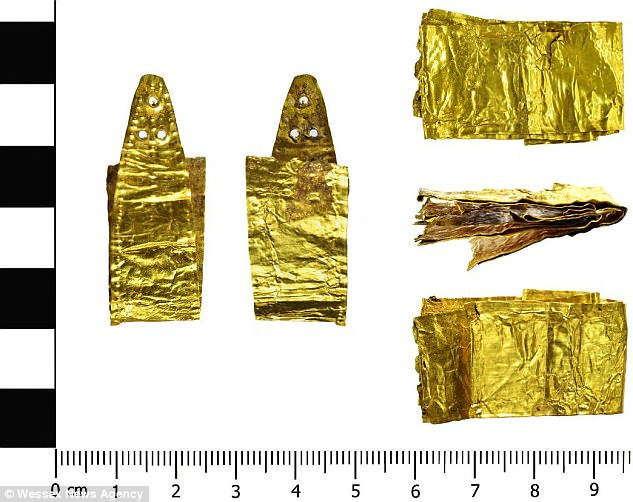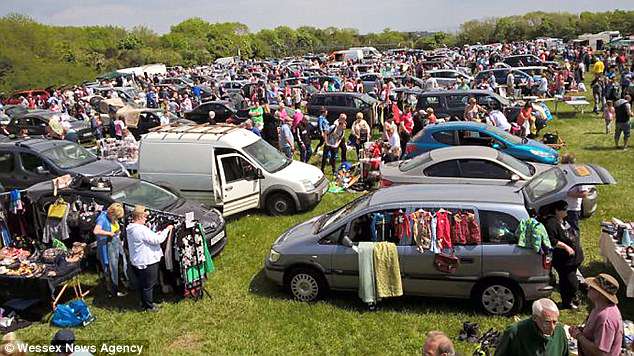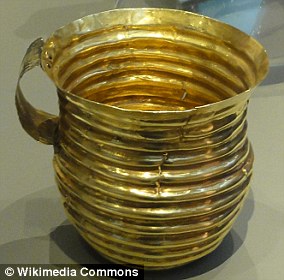One of the oldest and rarest pieces of gold ever found in Britain has been found in a box of odd watch parts bought at a car boot sale in Oxfordshire.
The 'incredibly rare' gold strip, which is thought to be from the early Bronze Age and dates to between 2,500 and 2,000 BC, could be worth as much as £2,000.
Experts said the strip could have once adorned the side of a sword or may have been used as extravagant neck jewellery.
Is this Britain's oldest gold? 4,500-year-old piece of treasure that could be worth £2,000 is found in a box of odd watch parts at a car boot sale
The 'incredibly rare' gold strip is thought to date back to the early Bronze Age
It could have once adorned a sword or been used as part of neck jewellery
Gold was bought by John Workman at a car boot sale in Berinsfield, Oxfordshire
Experts said a similar treasure found in Winchester was valued at £2,000
By Harry Pettit For Mailonline
23 April 2018
One of the oldest and rarest pieces of gold ever found in Britain has been found in a box of odd watch parts bought at a car boot sale in Oxfordshire.
The 'incredibly rare' gold strip, which is thought to be from the early Bronze Age and dates to between 2,500 and 2,000 BC, could be worth as much as £2,000.
Experts said the strip could have once adorned the side of a sword or may have been used as extravagant neck jewellery.

One of the oldest and rarest pieces of gold ever found in Britain has been found in a box of odd watch parts bought at a car boot sale in Oxfordshire. The 'incredibly rare' gold strip (pictured) is thought to be from the early Bronze Age and dates back to between 2,500 and 2,000 BC
Now folded in two pieces, the gold was bought by John Workman at a car boot sale in Berinsfield, south Oxfordshire, who said he did not know how valuable it was.
Anni Byard, finds liaison officer for Oxfordshire and West Berkshire with Oxfordshire County Council, said: 'There are only a handful of items similar to this. They are incredibly rare and as such we are not really sure what they were used for.
'This is why it is quite an important discovery because they are so very rare.
'The date is when you start to get the very first bits of gold in Britain', she said.
Despite being thousands of years old the treasure was relatively well-preserved in the box, which was bought in March 2016.
'As soon as I heard about it I knew it was Bronze Age and realised it was pretty unusual', said Ms Bynard.
'It could have been on the side of a sword or could have been worn around the neck as jewellery. We just don't know', she said.
Mr Workman spotted the unusual piece and showed it to friends who were interested in metal detecting.

Despite being thousands of years old the treasure was relatively well-preserved in the box, which was bought at a car boot sale in Oxfordshire in March 2016 (stock image)
He was then encouraged to get in touch with the British Museum, who revealed its ancient origins.
Ian Richardson, treasure registrar at the museum, explained the treasure was well-preserved because of the strong material.
He said: 'Some gold finds are in a great condition even after thousands of years because it is a very stable element and isn't going to tarnish like silver.'
A treasure inquest at Oxford Coroner's Court, on Tuesday, heard it was likely the object was found locally.
The ruling of treasure means items effectively belong to the public and are likely to be put on display in a museum.
The current market value of the gold will now be calculated and as The Oxfordshire Museum has expressed an interest in the piece the money is likely to go to the finder - but it is not clear how much John paid for the strip.
Ms Byard said: 'We don't know when this was found. It could have been found two years ago or 50 years ago and someone may just have not reported it.
'Very rare doesn't seem to do it justice'.

Now folded in two pieces, the gold was bought by John Workman at a car boot sale in Berinsfield, south Oxfordshire, who said he did not know how valuable it was
She said while it is unclear how much the gold could fetch, a similar strip of gold found near Winchester in 2000 was valued at £2,000.
The piece is the second item of historical treasure to turn up at Berinsfield Car Boot Sale after a gold foil, similar in design to a coin, with a hanging pendant loop called a bracteate, was found in 2011.
In England, Wales and Northern Ireland, all finders of gold and silver objects and groups of coins from the same finds, over 300 years old, have a legal obligation to report the items under the Treasure Act.
The objects must be reported to the coroner for the district within 14 days of making the discovery or within two weeks of realising the find might be treasure.
HOW WAS GOLD USED IN BRONZE AGE BRITAIN?

Bronze Age gold artefacts, such as this cup found in Cornwall, were used to designate high status
Between 2500 and 800 BC, communities in Britain first learned how to work metal, producing bronze, copper and gold items.
There are currently no known gold mines in Europe dated to the Bronze Age, so the metal was likely obtained using the panning technique.
Gold artefacts were used to designate the high status of those who wore or were buried with them.
These items included jewellery, pots, cups and small battle ornaments fixed to swords, daggers and other weaponary.
Around 1,500 gold artefacts dating to the Bronze Age survive in collections, with around 1000 from Ireland and 500 from Britain.
WHAT DO WE KNOW ABOUT BRONZE AGE BRITAIN?
The Bronze Age in Britain began around 2,000 BC and lasted for nearly 1,500 years.
It was a time when sophisticated bronze tools, pots and weapons were brought over from continental Europe.
Skulls uncovered from this period are vastly different from Stone Age skulls, which suggests this period of migration brought new ideas and new blood from overseas.
Bronze is made from 10 per cent tin and 90 per cent copper, both of which were in abundance at the time.
Crete appears to be a centre of expansion for the bronze trade in Europe and weapons first came over from the Mycenaeans in southern Russia.
It is widely believed bronze first came to Britain with the Beaker people who lived about 4,500 years ago in the temperate zones of Europe.
They received their name from their distinctive bell-shaped beakers, decorated in horizontal zones by finely toothed stamps.
The decorated pots are almost ubiquitous across Europe, and could have been used as drinking vessels or ceremonious urns.
Believed to be originally from Spain, the Beaker folk soon spread into central and western Europe in their search for metals.
Textile production was also under way at the time and people wore wrap-around skirts, tunics and cloaks. Men were generally clean-shaven and had long hair.
The dead were cremated or buried in small cemeteries near settlements.
This period was followed by the Iron Age which started around 650 BC and finished around 43 AD.
Read more: 'Oldest gold in Britain' found in a box of watch parts in Oxfordshire | Daily Mail Online
Follow us: @MailOnline on Twitter | DailyMail on Facebook
The 'incredibly rare' gold strip, which is thought to be from the early Bronze Age and dates to between 2,500 and 2,000 BC, could be worth as much as £2,000.
Experts said the strip could have once adorned the side of a sword or may have been used as extravagant neck jewellery.
Is this Britain's oldest gold? 4,500-year-old piece of treasure that could be worth £2,000 is found in a box of odd watch parts at a car boot sale
The 'incredibly rare' gold strip is thought to date back to the early Bronze Age
It could have once adorned a sword or been used as part of neck jewellery
Gold was bought by John Workman at a car boot sale in Berinsfield, Oxfordshire
Experts said a similar treasure found in Winchester was valued at £2,000
By Harry Pettit For Mailonline
23 April 2018
One of the oldest and rarest pieces of gold ever found in Britain has been found in a box of odd watch parts bought at a car boot sale in Oxfordshire.
The 'incredibly rare' gold strip, which is thought to be from the early Bronze Age and dates to between 2,500 and 2,000 BC, could be worth as much as £2,000.
Experts said the strip could have once adorned the side of a sword or may have been used as extravagant neck jewellery.

One of the oldest and rarest pieces of gold ever found in Britain has been found in a box of odd watch parts bought at a car boot sale in Oxfordshire. The 'incredibly rare' gold strip (pictured) is thought to be from the early Bronze Age and dates back to between 2,500 and 2,000 BC
Now folded in two pieces, the gold was bought by John Workman at a car boot sale in Berinsfield, south Oxfordshire, who said he did not know how valuable it was.
Anni Byard, finds liaison officer for Oxfordshire and West Berkshire with Oxfordshire County Council, said: 'There are only a handful of items similar to this. They are incredibly rare and as such we are not really sure what they were used for.
'This is why it is quite an important discovery because they are so very rare.
'The date is when you start to get the very first bits of gold in Britain', she said.
Despite being thousands of years old the treasure was relatively well-preserved in the box, which was bought in March 2016.
'As soon as I heard about it I knew it was Bronze Age and realised it was pretty unusual', said Ms Bynard.
'It could have been on the side of a sword or could have been worn around the neck as jewellery. We just don't know', she said.
Mr Workman spotted the unusual piece and showed it to friends who were interested in metal detecting.

Despite being thousands of years old the treasure was relatively well-preserved in the box, which was bought at a car boot sale in Oxfordshire in March 2016 (stock image)
He was then encouraged to get in touch with the British Museum, who revealed its ancient origins.
Ian Richardson, treasure registrar at the museum, explained the treasure was well-preserved because of the strong material.
He said: 'Some gold finds are in a great condition even after thousands of years because it is a very stable element and isn't going to tarnish like silver.'
A treasure inquest at Oxford Coroner's Court, on Tuesday, heard it was likely the object was found locally.
The ruling of treasure means items effectively belong to the public and are likely to be put on display in a museum.
The current market value of the gold will now be calculated and as The Oxfordshire Museum has expressed an interest in the piece the money is likely to go to the finder - but it is not clear how much John paid for the strip.
Ms Byard said: 'We don't know when this was found. It could have been found two years ago or 50 years ago and someone may just have not reported it.
'Very rare doesn't seem to do it justice'.

Now folded in two pieces, the gold was bought by John Workman at a car boot sale in Berinsfield, south Oxfordshire, who said he did not know how valuable it was
She said while it is unclear how much the gold could fetch, a similar strip of gold found near Winchester in 2000 was valued at £2,000.
The piece is the second item of historical treasure to turn up at Berinsfield Car Boot Sale after a gold foil, similar in design to a coin, with a hanging pendant loop called a bracteate, was found in 2011.
In England, Wales and Northern Ireland, all finders of gold and silver objects and groups of coins from the same finds, over 300 years old, have a legal obligation to report the items under the Treasure Act.
The objects must be reported to the coroner for the district within 14 days of making the discovery or within two weeks of realising the find might be treasure.
HOW WAS GOLD USED IN BRONZE AGE BRITAIN?

Bronze Age gold artefacts, such as this cup found in Cornwall, were used to designate high status
Between 2500 and 800 BC, communities in Britain first learned how to work metal, producing bronze, copper and gold items.
There are currently no known gold mines in Europe dated to the Bronze Age, so the metal was likely obtained using the panning technique.
Gold artefacts were used to designate the high status of those who wore or were buried with them.
These items included jewellery, pots, cups and small battle ornaments fixed to swords, daggers and other weaponary.
Around 1,500 gold artefacts dating to the Bronze Age survive in collections, with around 1000 from Ireland and 500 from Britain.
WHAT DO WE KNOW ABOUT BRONZE AGE BRITAIN?
The Bronze Age in Britain began around 2,000 BC and lasted for nearly 1,500 years.
It was a time when sophisticated bronze tools, pots and weapons were brought over from continental Europe.
Skulls uncovered from this period are vastly different from Stone Age skulls, which suggests this period of migration brought new ideas and new blood from overseas.
Bronze is made from 10 per cent tin and 90 per cent copper, both of which were in abundance at the time.
Crete appears to be a centre of expansion for the bronze trade in Europe and weapons first came over from the Mycenaeans in southern Russia.
It is widely believed bronze first came to Britain with the Beaker people who lived about 4,500 years ago in the temperate zones of Europe.
They received their name from their distinctive bell-shaped beakers, decorated in horizontal zones by finely toothed stamps.
The decorated pots are almost ubiquitous across Europe, and could have been used as drinking vessels or ceremonious urns.
Believed to be originally from Spain, the Beaker folk soon spread into central and western Europe in their search for metals.
Textile production was also under way at the time and people wore wrap-around skirts, tunics and cloaks. Men were generally clean-shaven and had long hair.
The dead were cremated or buried in small cemeteries near settlements.
This period was followed by the Iron Age which started around 650 BC and finished around 43 AD.
Read more: 'Oldest gold in Britain' found in a box of watch parts in Oxfordshire | Daily Mail Online
Follow us: @MailOnline on Twitter | DailyMail on Facebook
Last edited: